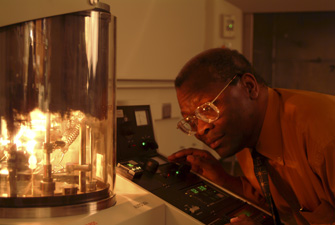A single hour of sunlight contains enough energy to meet global energy consumption for an entire year. With demand for energy on the rise and environmental pollution an increasing concern, scientists are exploring new ways to harness the sun's clean energy as an alternative to petroleum-based fuel.

A team of researchers led by Samson A. Jenekhe, UW professor of chemical engineering and chemistry, boosted the efficiency of organic solar cells by using self-assembled polymer nanowires that help to convert sunlight into electrical energy. Their work was featured in an article on the Journal of American Chemistry Society's Web site.
Jenekhe's team is expanding the scope of promising materials being explored for use in solar cells made from semiconducting polymers. These polymers are less expensive to produce and more flexible than the silicon used in today's solar rooftop panels and calculators, but still far less efficient.
"Solar power from the sun is the most abundant source of clean energy on earth," Jenekhe said. "The main challenge in fully exploiting this resource is in developing new technologies to significantly lower the cost of solar power conversion devices."
"Because current organic solar cells lag behind silicon photovoltaics in power conversion efficiency," said Jenekhe, "a major focus of researchers is to improve the efficiency of organic photovoltaics to close this gap in performance."

Researchers prepared the polymer nanowires by solution-phase self-assembly, slowly cooling a hot solution to room temperature in a dark environment.
Although polymer solar cells have been made and studied for a long time, Jenekhe said using self-assembly "brings a new dimension with enormous potential to transform the design, fabrication, and performance of solar cells."
The challenge that scientists face is how to precisely control the size, shape, and make-up of the component materials used to fabricate polymer solar cells. "Self-assembly automatically does the process and quality control in bringing materials together for constructing a solar cell," Jenekhe said.
The self-assembled nanowires perform multiple functions. First, they absorb the sunlight or photons. Second, their large surface area enables more efficient conversion of the absorbed photons from sunlight into charges or electrical current. Third, they serve as the conduit for moving the charges produced to external collecting electrodes.
Also important to the success of the nanowires is their stability. "Their excellent stability means that they retain their sizes, shape, surface area, and ability to perform the multiple functions they serve," Jenekhe said. "Stability over time is necessary to maintain the performance of the device."
Jenekhe's team used the material poly(3-butylthiophene) to build the polymer solar cells, which are pushing beyond the 3.5 -percent power conversion efficiency as their work continues. This rivals the power conversion efficiency of the material poly(3-hexylthiophene), which has been the focus of most research effort on polymer solar cells so far.
"One of the attractive aspects of the nanowire approach is that we are not limited to using one specific polymer," Jenekhe said. "We have already constructed solar cells from nanowires of other polymers that are also more efficient than poly(3-hexylthiophene)."
Jenekhe's research team included Hao Xin, chemical engineering postdoctoral research associate, Guoqiang Ren, chemical engineering graduate student, and Felix Sunjoo Kim, chemical engineering graduate student. Their work was featured in the April 23, 2008 issue of the Journal of the American chemical Society (volume 130, page 5424).
The research was made possible with support from the U.S. Department of Energy's Office of Basic Energy Sciences, the National Science Foundation and the Air Force Office of Scientific Research.